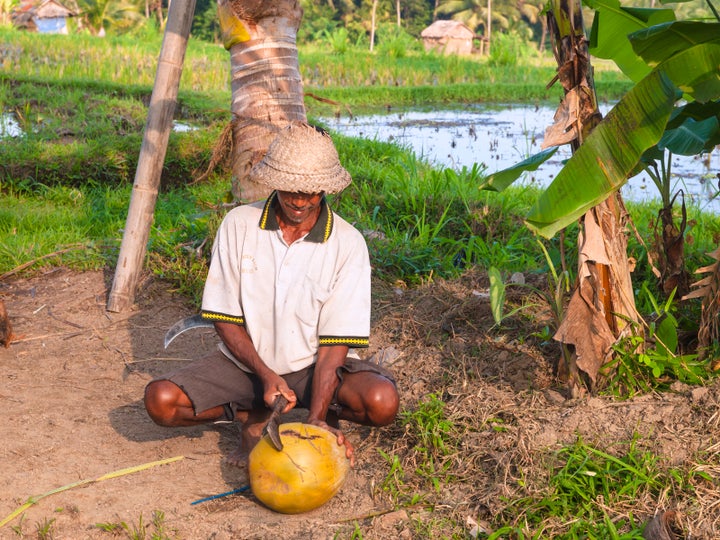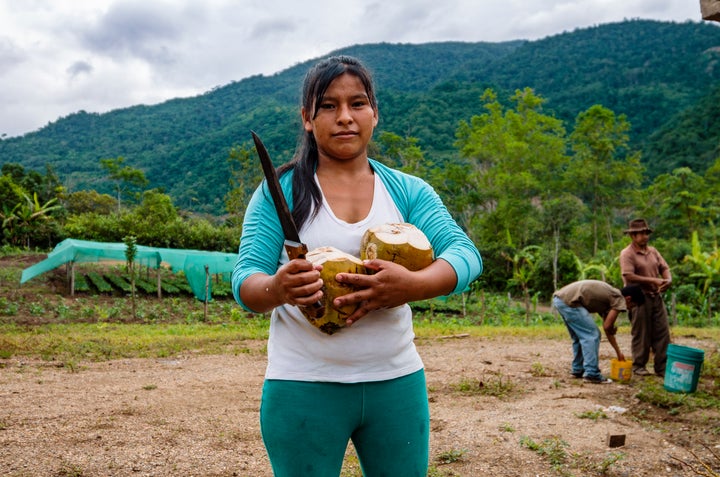In the last decade, the humble coconut has experienced a tremendous boom in the Western world. It has gone from being an exotic tropical fruit, limited to desserts and the occasional pina colada, to an important pantry staple in its many forms ― coconut oil, water, milk, cream, sugar, flour, flakes, chips and more.
The growing wellness industry has encouraged consumers to fold more coconut products into their lives. Coconut oil, for instance, has been touted for its antioxidant, anti-inflammatory and even fat-burning properties.
But there’s another side to the demand for more coconut: It poses a threat to the environment and fails to produce living wages for farmers.
While environmentalists encourage people to eat locally, sustainably and with a minimal carbon footprint, there is nothing local ― or usually even continental ― about the consumption of coconut in the United States and Europe, the largest importers of coconut products.

Coconut is native to Southeast Asia. While it grows in tropical countries around the world, nearly three-quarters of the world’s supply still comes from the Philippines, Indonesia and India. According to a report released by Allied Market Research, the global coconut products industry was pegged at $12.75 billion in 2019 and is projected to reach $31.1 billion by 2026.
The demand for coconuts in developed countries is putting a strain on their natural sustainable production by farmers in the developing world. Here’s what has gone wrong.
Coconut production utilizes harmful chemical fertilizers.
To increase their farm’s profitability, many coconut farmers engage in “monocropping” ― growing just the one crop on the same land, year after year. The problem is, this practice eventually depletes nutrients from the soil, which then forces farmers to use chemical fertilizers, which are harmful to the environment.

Fueled by the newfound enthusiasm for coconut products in the West, major coconut producers have turned over massive acreage to this monoculture, leading to chemically intensive farming and ruining the biodiversity of land on which the coconut palms are planted.
“We end up creating a monocrop plantation that will wipe out all other crops,” said Tomy Mathew, founder of Fair Trade Alliance Kerala and an Indian fair trade and organic certified company that exports coconut products to the U.S. and Europe.
Mathew noted that large plantations in the Indian state of Tamil Nadu, for example, are located in already water-starved regions whose water supplies are now being depleted “at an alarming rate to irrigate these farms.”
“As it happened with cocoa, as with vanilla, that sort of resource-intensive production is not sustainable in the long run,” Mathew said. Farmers working vanilla and cocoa plantations in the Indian state of Kerala saw tremendous loss of income when the prices for those commodities crashed. Afterward, he said, many of those farmers adopted a more sustainable multi-crop approach, circulating a variety of crops on their lands and distributing the risk that comes with planting just one.
“I believe that the growth of ‘food trends’ in the West/Global North puts an unfair and difficult burden on the poorer farmers in the Global South,” said Simrit Malhi, a permaculture farmer at her family-owned Roundstone Farms. “We must remember that trees like coconut or avocado take a minimum of three to five years to mature and start producing fruit. Often by the time the fruits are ready, the trend has already passed, forcing poorer farmers to farm chemically to get faster results.”
She pointed, as an example, to the environmental costs of chemically grown avocados in Mexico, planted to feed the avocado boom in the U.S.
As coconut trees age, their yield declines ― and so does farmers’ income.
Coconut trees have a productive life of 30 to 40 years. As they age, they produce fewer and fewer coconuts. With many of their trees long past peak productivity, the coconut farming industry in Asia has been plagued with low yields for years. Harvests have declined since global production of coconut peaked in 2013.
Despite Western demand, the Asia-Pacific region experienced an overall increase in production of only 1.3% per year from 2000 to 2015, while the Philippines has actually seen a decline in production in recent years. For many farmers, growing coconuts no longer fetches a sustainable income.

There are other challenges as well. “Most planters are shying away from coconut production as a result of exorbitant wages being demanded to climb coconut trees and de-husk nuts,” said Mathew Jose, founder of the company Farm Origin. He said market conditions in Kerala, the highest coconut-producing state in India, are one of the big reasons that production is on the decline. “Farmers in that region are choosing instead to either commercialize their land or grow exotic fruit trees (rambutan, mangosteen) to increase revenue,” he said.
Despite the surge in global consumption, farmers see low returns.
The ultimate profits from coconut products aren’t trickling all the way down to the farmers.
The conglomerates whose products crowd supermarket shelves source coconuts from large-scale monocropping plantations that are corporatized and mechanized to ensure consistent supply. This leaves no significant space for the small, marginalized farmers struggling just to break even with their cost of production. They miss out on the benefits of this surging trade.
Tomy Mathew explained that aggregators and middlemen in the coconut trade drive fluctuations in the market price of coconut, which eventually affects farmers’ livelihoods. “When you average out [the market price fluctuation] against two to three harvest periods, the farmers are not being compensated,” he said.
Jose noted that despite the increased demand for coconut products, “planters aren’t seeing a corresponding increase in prices for raw coconuts. Most of the price increase happens after there is some value add in the supply chain.”
In other words, as the commodity is sold from farmers to wholesalers to manufacturing and processing units, as it’s packaged, exported and retailed, those other parts of the supply chain siphon off their profits. Virtually nothing of the final price of the packaged product is really reaching the primary producer.

“If you work back that money of a $20 coconut oil, you will come back to a coconut being sold for [14 cents]. Unless it’s a supply chain that promises a fair price to the primary producer, I would look at this product with a huge question mark,” Mathew said.
What consumers can do to encourage a fair supply chain.
In the U.S., consumer attention to coconut products remains focused on health issues and has yet to consider the ethical sourcing of these products. So what’s the answer?
“It’s extremely important to ask questions about sustainable supply chains,” said Mathew, stressing the need for people to hold accountable the brands they patronize. In particular, he suggested looking for brands that try to ensure fair prices for coconut farmers and encourage multi-crop farming.
But the trade in commodities like coffee, tea, cocoa, sugar, spices and coconut has historically been dictated by international consumption patterns and driven by colonization. The repercussions of this trade must necessarily be confronted and tackled.
While small niche companies are striving to build a more equitable, sustainable system, a majority of our food supply comes through massive corporate-run chains. Ultimately, a consumer-led movement will need to push for change and seek accountability from those corporations.
What people can do now is diversify their pantry to include a healthy mix of locally grown products along with those responsibly obtained from other parts of the world. Imported products can be an occasional indulgence, not a thoughtless trend. This would certainly go some way to help reduce the burden on farmers in the developing world to cultivate at breakneck speed at the whim of the West.